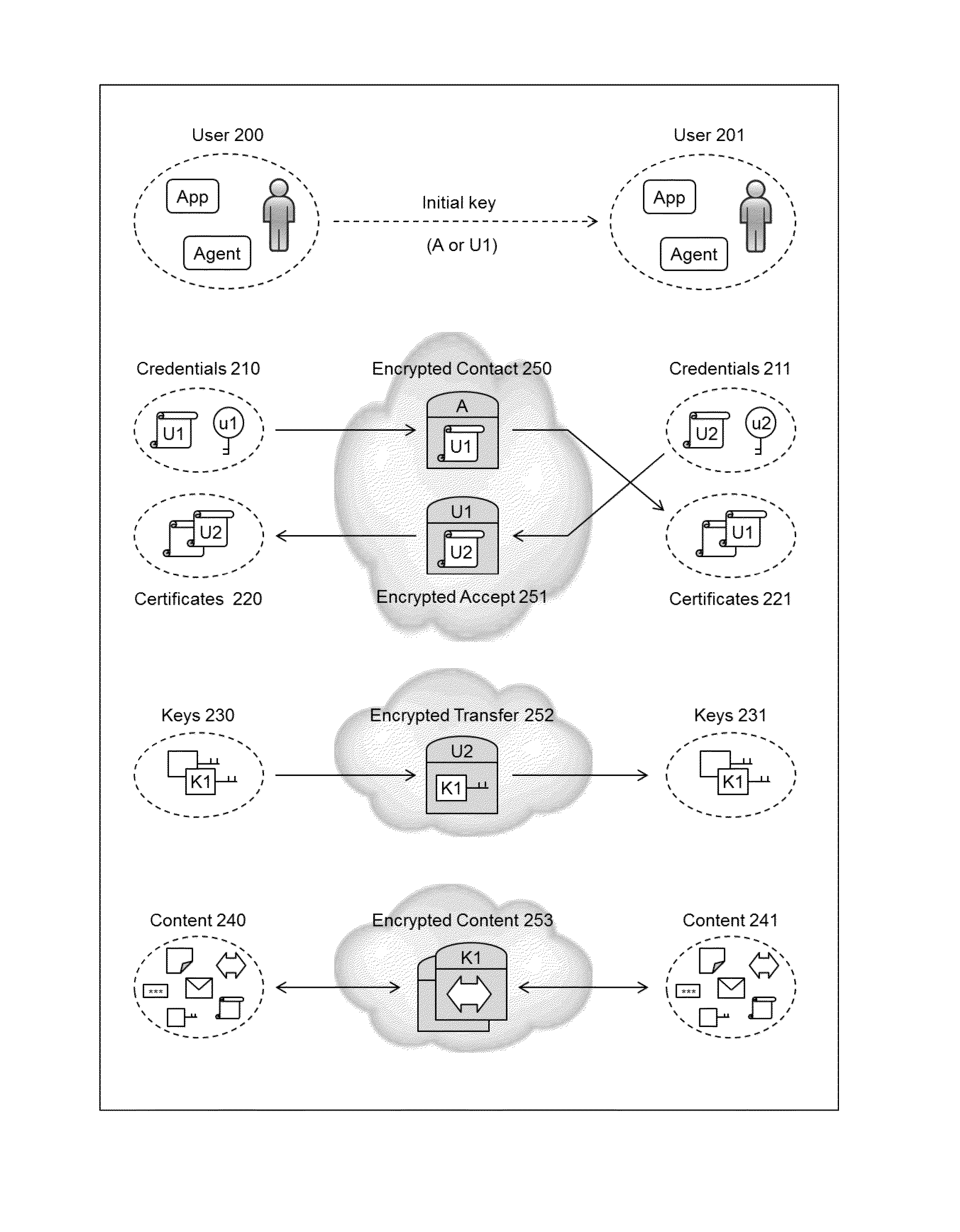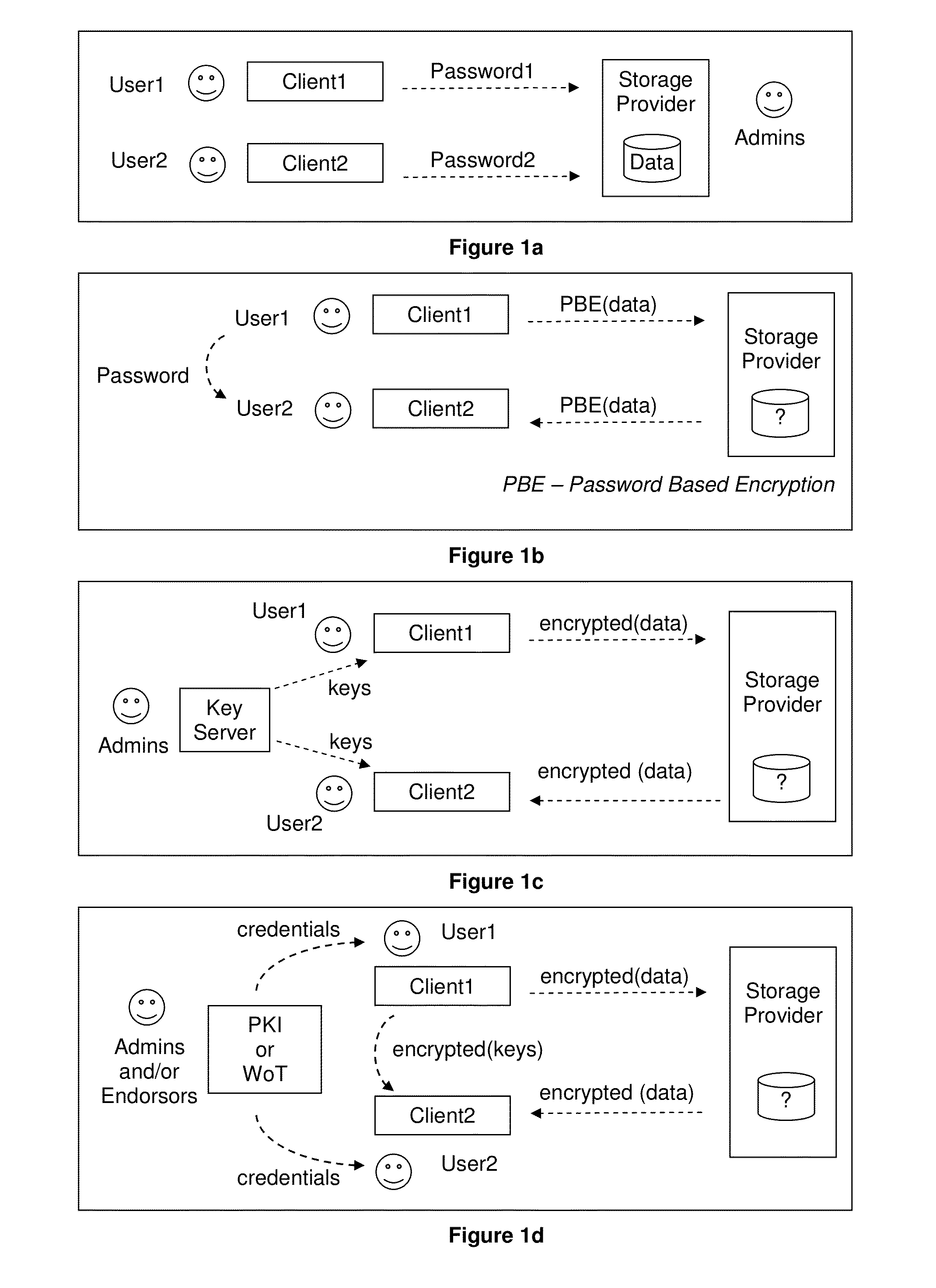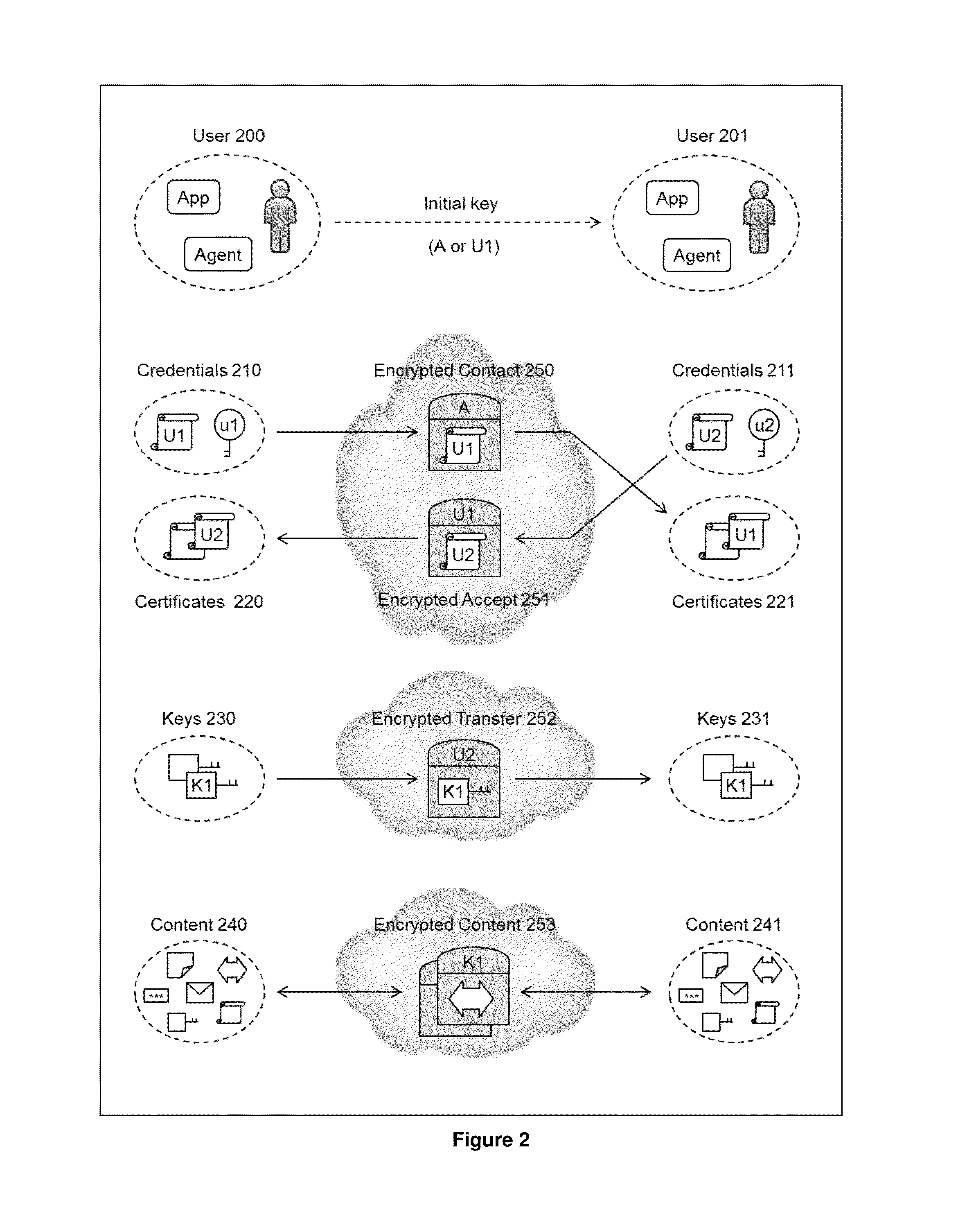This approach may be considered insufficient if strong security and / or privacy is required.P2P—Peer-to-Peer approaches tend to be
application specific (e.g.
instant messaging) and / or require real-time connections.
This approach relies on the resources of end systems and is therefore unable to leverage “cloud” benefits such as availability, vast storage, low cost etc.Enterprise—Organisational oriented approaches tend to be closed and / or centralised.
This approach has difficulty scaling to the wider internet and attempts to do so, for example “federation”, are considered to largely not have been successful as evidenced by the lack of working systems.WoT—Web of Trust systems tend to use decentralisation to avoid authority and / or intermediate parties.
Attempts to make WoT work in the wider internet have generally had difficulty with scale and complexity.PKI—Public Key Infrastructures tend to work well in closed communities, but have problems scaling because of authoritarian, inflexible and / or centralised nature of most implementations.
In general, PKI's have not been successful in the wider internet because of difficulties to do with complexity, manual processes, jurisdiction and cost.
Note that
server-side
encryption has little additional security benefit as
server-side keys have mostly the same risks as
server-side infrastructure.
Key management may have complexity, cost and challenges including
key generation, storage, duplication, distribution, access, protection,
rollover, rotation,
recovery, removal,
revocation etc.
If public / private
key cryptography is used to help distribute keys, then there may be additional problems of managing certificates, governance, issuance, proof-of-identity, renewal etc.
If credentials are compromised, then prior art may
handle this situation poorly.
Obviously, this involves risks, as an attacker may
exploit a window to use compromised token or make use of
clock manipulation.Remove the user from the
system.
Clearly, de-provisioning a user is unacceptable if the user has simply lost their credentials and needs them to be re-instated.Re-instating the user using an automated process, for example using a “
password reset” procedure.
In prior art, this automated process may be considered weak, for example, because an attacker could make use of a compromised account, especially email account, to abuse the
password reset process.Re-instating the user using a manual process, for example by having an administrator reset credentials.
In prior art, this manual process may be considered weak, for example, because an attacker could use social
engineering techniques to trick an administrator into the reset.
Note that an attacker who manages to impersonate another user may only be able to access a victim's data after convincing some or all of the victim's contacts of their authenticity, which may be difficult, if not impossible, as it involves out-of-band, usually personal, vetting or
verification.At the
Control Layer, the re-registering user may need to be re-invited to each of the boxes they previously had access to.
This further makes the task of an attacker difficult, because now the attacker needs to convince each data owner to invite them back into a box.
If keys were rotated or rolled-over, especially if content keys were re-encrypted using the new box keys, then this may close another path of an attacker e.g. a user which previously was trusted, but who went rogue and kept previous box keys, those previous keys may have become useless.
Thus, even if there are security problems with intermediate systems, the most an attacker may be able to obtain is encrypted data.
Such an approach may introduce additional barriers to an attacker.
This may make any data, whether user, agent or
system information, relatively in indistinguishable from each other as well as make any relationships between boxes or users relatively difficult to deduce.
This means that server-side operators may be relatively “blind” to what is being transferred or shared between users and that intermediate administrators may be relatively powerless to interfere with policies and other management co-ordination between end-
system agents.
It means that any break in the system may only affect the particular partition or data items encrypted with those keys.
Whilst this achieves control independent from interference by any third parties, it relies on the availability and resources of end-systems, which may be inappropriate for general desktop systems, mobile devices or systems behind company firewalls.
This may mean that server-side operators are relatively powerless to access information themselves or change access rules to data as they may have no means to obtain or control the distribution of keys.
In prior art, such administrators may be a problem as they may have elevated privileges necessary to operate systems, particularly server-side systems, and therefore the capacity to abuse those privileges.
In particular, prior art systems may result in trust being indirect, in that two parties may assume to trust each other via the TTP.
A further complication with WoT systems is that if a user is revoked then this may affect and / or collapse trust calculations for all users for which the revoking user had counter signed.
Because all information is end-to-end encrypted, intermediate parties may not be able to determine which files are user content and which files are system messages, for example, granting of privileges etc.
Though central services may be required, the centralised role may be essentially limited to providing a
record of where to look for data, signing certificates and providing a place to check if credentials have been revoked.
However, there may be security and privacy risks with essentially all-powerful administrators having overriding control over many, if not all, accounts and / or credentials.
This may be a highly common activity as it is well known in the industry that a majority of support problems relate to forgotten passwords.
In prior-art systems, de-provisioning may be problematic, for example, having manual processes to ensure that when an employee's role changes that all appropriate permissions are removed or if an employee leaves, removing all appropriate permissions.
As a result, the amount of administration required by centralised services, such as remote services and / or repository services, may be relatively small.
For example, prior art may require significant effort with
membership management, including enrolment, privileges, group management etc.
In particular, group management may be a relatively complex issue, e.g. because of the need to manage dynamic and / or conflicting requirements of groups which may be unpredictable, transient, complex, overlapping, disjoint, dormant, out-dated etc.
This may be unlike prior art in which central servers and / or central administration may become a
bottleneck.
In particular, requirements on remote services or storage services may be relatively low, thus making the system scalable.
In prior art
encryption systems, there may be a trade-off between safety and security.
Safety requires that keys are always recoverable, as if keys are lost, then encrypted data may be unusable.
Note that regaining credentials is not sufficient to regain previous access: in addition, it further requires obtaining copies of certificates and / or regaining access to each box.
The escrowing of signing private keys is considered not necessary and a security risk as any breach in security may result in obtaining signing keys which may subsequently allow impersonation of the real user.
Preferably, escrowed keys are stored encrypted by a computationally difficult means of obtaining them.
This may make it difficult to steal a large number of keys, as decrypting a large number of
escrow keys may require relatively large amounts of computing power.
Preferably, access to an
escrow server would involve legal and / or procedural constraints, such as needing a court order or signed military order, requiring multiple signatories and / or approvals etc.
A further problem in prior-art may be the quality of certificates being used, as a user may not understand the appropriateness of certificates they receive.
Overall setting up end-to-end encrypted email may be a manual, arduous, complex, technical and / or relatively difficult process that requires end-users to have expert knowledge and thus is often cited as a major reason why S /
MIME has not had widespread adoption.
This addresses a severe limitation of most peer-to-peer (P2P) systems, such as IM, chat, forums, voice calls, video calls etc because they rely on end systems to maintain logs and / or histories, which may have limited storage space and / or not suitable for long term reliable storage.
Such a signing process for documents may be costly and / or
time consuming.
In prior art, it is often regarded as the most difficult aspect of cryptosystems because of the manual processes that must be implemented around the lifecycle and / or management of keys.
This may result in the need to manage more
encryption keys, often with stringent key lifecycle requirements.
As a result, there may be a compounding problem of number of keys, complexity in managing the lifecycle of keys and diversity in applications requiring keys.
In this context, the
key management problem may become exceedingly difficult.
However key-servers may have significant problems, for example:Having a concentrated source of keys may make key-servers a significant target for
attack.There needs to be very strong controls around the security and administrators of key-servers as a single breach may compromise an entire system.If keys need to be shared across organisations, then there may be significant jurisdiction and / or governance and / or liability problems with running key-servers.
However,
key management becomes increasingly complex as the size of projects grow, as the number of projects goes, as the amount of staff changes in projects occur, as the richness of access levels increases etc.
This results in increasing administrative burden, especially as projects go live and the responsibility may be passed to “operations”.
Though encryption may protect such information, the key management associated may be difficult and / or complex.
As enterprises take
advantage of
cloud computing environments, via both third-party services and custom-developed applications, the risk of exposing sensitive data may increase.
Because cloud servers may not have a physical “location” security may be unpredictable and / or compliance with data residency regulations may become difficult.
The on-premise protection may add an extra layer of protection by making it relatively impossible to obtain event the encrypted information.
This may be quite different from prior art which may allow for the publication of URL's of content, which may be a security problem as the “secret” URL to a file can easily become known and may be a privacy problem because it gives away that content exists.
When such limits and / or conditions are reached, the repository service may make further files inaccessible.
This is because prior-art messaging may not be private in several aspects of their operation, for example in the provision of a “
directory” of registered users and / or storing of messages on behalf of users which relies on the security and privacy of the provided services.
Problems in the prior art is that users and / or businesses making use of the CRM may have
highly sensitive information in the CRM which could be accessed by the CRM provider.
In particular, mobile devices, such as laptops, tablets or smart phones may be relatively easily lost, stolen or broken into and so keeping data encrypted on those devices may prove vital to prevent this avenue of data breaches.
A further requirement, particularly by enterprises, is that if a
mobile device is lost or stolen, that information on it may be destroyed and / or purged.
 Login to View More
Login to View More  Login to View More
Login to View More 


